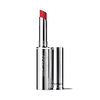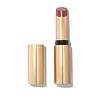What's inside
What's inside
 Key Ingredients
Key Ingredients

 Benefits
Benefits

No benefits
 Concerns
Concerns

 Ingredients Side-by-side
Ingredients Side-by-side

Dimethicone
EmollientSynthetic Wax
AbrasiveTrimethylsiloxysilicate
EmollientOctyldodecanol
EmollientEthylene/Propylene Copolymer
AbrasivePassiflora Edulis Seed Oil
EmollientPolyhydroxystearic Acid
EmulsifyingSilica
AbrasiveDisteardimonium Hectorite
StabilisingAroma
Mica
Cosmetic ColorantCI 77891
Cosmetic ColorantCI 77491
Cosmetic ColorantCI 77492
Cosmetic ColorantCI 77499
Cosmetic ColorantCI 77163
Cosmetic ColorantCI 42090
Cosmetic ColorantCI 77742
Cosmetic ColorantCI 15850
Cosmetic ColorantCI 45380
Cosmetic ColorantCI 73360
Cosmetic ColorantCI 45410
Cosmetic ColorantCI 19140
Cosmetic ColorantCI 15985
Cosmetic ColorantDimethicone, Synthetic Wax, Trimethylsiloxysilicate, Octyldodecanol, Ethylene/Propylene Copolymer, Passiflora Edulis Seed Oil, Polyhydroxystearic Acid, Silica, Disteardimonium Hectorite, Aroma, Mica, CI 77891, CI 77491, CI 77492, CI 77499, CI 77163, CI 42090, CI 77742, CI 15850, CI 45380, CI 73360, CI 45410, CI 19140, CI 15985
Polyglyceryl-2 Triisostearate
EmulsifyingPolyglyceryl-6 Polyricinoleate
EmulsifyingOctyldodecanol
EmollientBis-Diglyceryl Polyacyladipate-2
EmollientPolyglyceryl-3 Diisostearate
EmulsifyingEuphorbia Cerifera Wax
Vp/Eicosene Copolymer
Synthetic Wax
AbrasiveSimmondsia Chinensis Seed Oil
EmollientAroma
Ethylene/Propylene Copolymer
AbrasiveLimnanthes Alba Seed Oil
Skin ConditioningDicalcium Phosphate
AbrasiveAstrocaryum Murumuru Seed Butter
EmollientPunica Granatum Flower Extract
Skin ConditioningPentaerythrityl Tetra-Di-T-Butyl Hydroxyhydrocinnamate
AntioxidantButyrospermum Parkii Butter Extract
Skin ConditioningIrvingia Gabonensis Kernel Butter
Skin ConditioningHydrogenated Coco-Glycerides
EmollientDisteardimonium Hectorite
StabilisingPolyhydroxystearic Acid
EmulsifyingIron Oxides
CI 77891
Cosmetic ColorantCI 15850
Cosmetic ColorantCI 42090
Cosmetic ColorantPolyglyceryl-2 Triisostearate, Polyglyceryl-6 Polyricinoleate, Octyldodecanol, Bis-Diglyceryl Polyacyladipate-2, Polyglyceryl-3 Diisostearate, Euphorbia Cerifera Wax, Vp/Eicosene Copolymer, Synthetic Wax, Simmondsia Chinensis Seed Oil, Aroma, Ethylene/Propylene Copolymer, Limnanthes Alba Seed Oil, Dicalcium Phosphate, Astrocaryum Murumuru Seed Butter, Punica Granatum Flower Extract, Pentaerythrityl Tetra-Di-T-Butyl Hydroxyhydrocinnamate, Butyrospermum Parkii Butter Extract, Irvingia Gabonensis Kernel Butter, Hydrogenated Coco-Glycerides, Disteardimonium Hectorite, Polyhydroxystearic Acid, Iron Oxides, CI 77891, CI 15850, CI 42090
Ingredients Explained
These ingredients are found in both products.
Ingredients higher up in an ingredient list are typically present in a larger amount.
Aroma refers to an ingredient, or mixture of ingredients, that impart or mask a flavor.
The name is slightly confusing. This is because INCI associates aroma with flavor instead of smell.
Here is the official definition from the The International Cosmetic Ingredient Dictionary and Handbook:
“Aroma is a term for ingredient labeling used to identify that a product contains a material or combination of materials normally added to a cosmetic to produce or to mask a particular flavor.”
INCI shows the only purpose of aroma to be "flavouring".
However, due to regulation differences, some companies may use aroma in place of parfum.
In Canada, this ingredient only has to be listed in concentrations above 1%.
Learn more about AromaCi 15850 is the pigment color red. It is an azo dye and created synthetically.
Azo dyes need to be thoroughly purified before use. This allows them to be more stable and longer-lasting.
This ingredient is common in foundations, lipsticks, and blushes. This color is described as brown/orangey red.
It has many secondary names such as Red 6 and Red 7. According to a manufacturer, Red 6 usually contains aluminum.
Learn more about CI 15850Ci 42090 is a synthetic dye created from petroleum. It is used to give a bright blue color to cosmetics, medicine, and food.
Ci 77891 is a white pigment from Titanium dioxide. It is naturally found in minerals such as rutile and ilmenite.
It's main function is to add a white color to cosmetics. It can also be mixed with other colors to create different shades.
Ci 77891 is commonly found in sunscreens due to its ability to block UV rays.
Learn more about CI 77891Disteardimonium Hectorite comes from the clay mineral named hectorite. It is used to add thickness to a product.
It can also help stabilize a product by helping to disperse other ingredients.
Hectorite is a rare, white clay mineral.
Learn more about Disteardimonium HectoriteEthylene/Propylene Copolymer is an exfoliant.
Octyldodecanol is a fatty alcohol. It is primarily used to enhance the texture of products.
As an emulsifier, Octyldodecanol helps prevent the oils and waters from separating. It also prevents ingredients from creating foam when shaken.
Octyldodecanol is created by reducing fatty acid to an alcohol.
Due to its high molecular weight, it does not get absorbed into the skin.
Learn more about OctyldodecanolPolyhydroxystearic Acid is a soft wax made from castor oil.
It is is a texture thickener, emulsifier, and film-former. Emulsifiers prevent ingredients from separating, such as oils and waters.
Polyhydroxystearic Acid may not be fungal acne safe.
Learn more about Polyhydroxystearic AcidSynthetic Wax is created from fossil fuels such as natural gas. It is used to enhance texture, adjust pH, and as an occlusive.
It may also be used as an abrasive ingredient to exfoliate the skin.
Synthetic Wax may not be fungal acne safe.
Learn more about Synthetic Wax